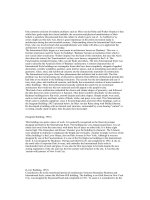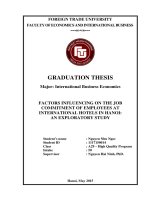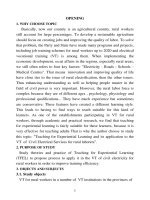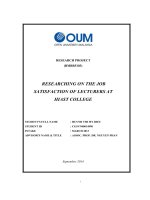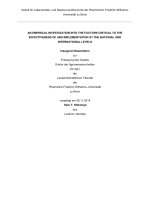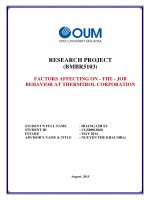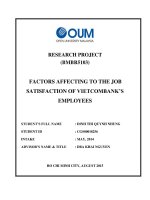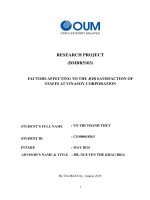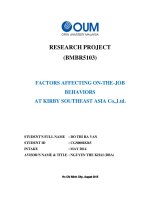Factors affecting to the job satisfaction of vietcombanks employees
Bạn đang xem bản rút gọn của tài liệu. Xem và tải ngay bản đầy đủ của tài liệu tại đây (1.88 MB, 97 trang )
RESEARCH PROJECT
(BMBR5103)
FACTORS AFFECTING TO THE JOB
SATISFACTION OF VIETCOMBANK’S
EMPLOYEES
STUDENT’S FULL NAME
: DINH THI QUYNH NHUNG
STUDENT ID
: CGS00018256
INTAKE
: MAY, 2014
ADVISOR’S NAME & TITLE
: DBA KHAI NGUYEN
HO CHI MINH CITY, AUGUST 2015
Advisor’s Assessment
---------------------------------------------------------------------------------------------------------------------------------------------------------------------------------------------------------------------------------------------------------------------------------------------------------------------------------------------------------------------------------------------------------------------------------------------------------------------------------------------------------------------------------------------------------------------------------------------------------------------------------------------------------------------------------------------------------------------------------------------------------------------------------------------------------------------------------------------------------------------------------------------------------------------------------
Advisor’s signature
Nguyen The Khai, DBA
Student: Dinh Thi Quynh Nhung – MBAOUM0514 K14C
1
TABLE OF CONTENTS
ACKNOWLEDGEMENT ............................................................................................ 5
LIST OF FIGURES ...................................................................................................... 6
LIST OF TABLE........................................................................................................... 7
ABSTRACT ................................................................................................................... 8
CHAPTER I: INTRODUCTION ................................................................................ 9
1.1
RESEARCH INTRODUCTION ...................................................................... 9
1.1.1 Motivation of the research ........................................................................ 9
1.1.2 The research problem statement ............................................................. 10
1.1.3 Significance of the research .................................................................... 11
1.1.4 Purpose of the research ........................................................................... 11
1.1.5 Scope of the research .............................................................................. 12
1.1.6 Question of the research.......................................................................... 12
1.2
INTRODUCTION OF VIECOMBANK........................................................ 13
1.2.1 Overview of Vietcombank ...................................................................... 13
1.2.2 Organizational structure of Vietcombank ............................................... 18
1.2.3 Management system of Vietcombank ..................................................... 21
1.2.4 Corporate culture of Vietcombank .......................................................... 21
CHAPTER II: LITERATURE REVIEW................................................................. 24
2.1
Job satisfaction ................................................................................................... 24
2.2
Supervisory support ........................................................................................... 28
2.3
Perceived organizational support ....................................................................... 30
2.4
Performance appraisal system knowledge ......................................................... 32
2.5
Perceived ability - job fit .................................................................................... 35
2.6
Need hierarchy theory for job satisfaction ......................................................... 37
Student: Dinh Thi Quynh Nhung – MBAOUM0514 K14C
2
CHAPTER III: RESEARCH MODEL AND HYPOTHESIS ................................ 39
3.1
Research model .................................................................................................. 39
3.2
Contructs ........................................................................................................... 40
3.3
The relationship between each independent variable and dependent variable and
Research Hypothesis ..................................................................................................... 40
3.3.1 The relationship between supervisory support and job satisfaction and
hypothesis 1 ................................................................................................................... 40
3.3.2 The relationship between perceived organizational support and job
satisfaction and hypothesis 2 ......................................................................................... 41
3.3.3 The relationship between performance appraisal system knowledge and
job satisfaction and hypothesis 3................................................................................... 42
3.3.4 The relationship between percieved ability – job fit and job satisfaction
and hypothesis 4 ............................................................................................................ 43
3.4
Research design .................................................................................................. 44
3.5
Measures of constructs ........................................................................................ 45
3.5.1 Supervisory support ................................................................................ 45
3.5.2 Perceived organizational support ............................................................ 47
3.5.3 Performance appraisal system knowledge .............................................. 49
3.5.4 Perceived ability - job fit ......................................................................... 51
3.5.5 Job satisfaction ........................................................................................ 53
3.6
Research Participants ......................................................................................... 53
3.7
Sources of data ................................................................................................... 53
3.7.1 Primary data ............................................................................................ 53
3.7.2 Secondary data ........................................................................................ 54
3.8
Procedure for Data Collection............................................................................ 54
3.8.1 Data collection tools........................................................................................... 54
3.8.2 Data collection method ...................................................................................... 54
Student: Dinh Thi Quynh Nhung – MBAOUM0514 K14C
3
CHAPTER IV: ANALYSIS AND RESULTS ......................................................... 56
4.1.
Methods of analysis ........................................................................................... 56
4.1.1 Descriptive analysis ................................................................................ 56
4.1.2 Correlation .............................................................................................. 56
4.2
Analysis general and demographic information of the respondents .................. 58
4.3
Cronbach’s Alpha (Reliability) .......................................................................... 60
4.4
Descriptive Analysis .......................................................................................... 62
4.5
Correlations among variables............................................................................. 63
4.6
Hypothesis Testing Result ................................................................................. 65
4.6.1 Hypothesis 1 Testing Result ................................................................... 66
4.6.2 Hypothesis 2 Testing Result ................................................................... 67
4.6.3 Hypothesis 3 Testing Result ................................................................... 67
4.6.4 Hypothesis 4 Testing Result ................................................................... 68
CHAPTER V: CONCLUSION ................................................................................. 69
5.1
Summary of the results ...................................................................................... 69
5.2
Discussion and Recommendation ...................................................................... 70
5.2.1 Discussion ............................................................................................... 70
5.2.2 Recommendation .................................................................................... 73
5.3
Limitations of the research ................................................................................. 76
REFERENCES ............................................................................................................ 78
APPENDIX A .............................................................................................................. 82
Student: Dinh Thi Quynh Nhung – MBAOUM0514 K14C
4
ACKNOWLEDGEMENT
First and foremost, I would like to express my sincere gratitude to my advisor
DBA KHAI NGUYEN for his patience, motivation, enthusiasm, and immense
knowledge in the continuous support for my research. Without his guidance, I could
not have finished it as it is now. Besides, his lessons and guidance provide me with
necessary knowledge as well as life inspiration. He is whom I could never forget in the
rest of my life.
Beside my dearest lecturers, my sincere thanks goes to my colleagues at
Vietcombank Sai Gon South Branch who had help me to complete the questionnaire in
order to help me conduct this research.
I would like to show my appreciation for some my bestfriends always share
their knowledges and experience with me.
Last but not least, I am thankful for my family, my parents support spirit for me
throughout the period of time I study MBA program.
Ho Chi Minh, August 2015.
Student: Dinh Thi Quynh Nhung – MBAOUM0514 K14C
5
LIST OF FIGURES
Figure 1: Vietcombank Market Position ....................................................................... 15
Figure 2: Vietcombank's logo and slogan ..................................................................... 17
Figure 3: Current Corporate Structure of Vietcombank ............................................... 18
Figure 4: Organizational structure of Vietcombank ..................................................... 19
Figure 5: Targeted Corporate Structure of Vietcombank ............................................. 20
Figure 6: Management system of Vietcombank ........................................................... 21
Figure 7: Hypothesized Research Model ..................................................................... 39
Figure 8: Participant's Gender ....................................................................................... 58
Figure 9: Participant's Age ............................................................................................ 58
Figure 10: Participant's Acamedic Degree .................................................................... 59
Figure 11: Participant's Working seniority ................................................................... 59
Figure 12: Participant's Working Position .................................................................... 60
Student: Dinh Thi Quynh Nhung – MBAOUM0514 K14C
6
LIST OF TABLES
Table 1: The profile of Vietcombank ............................................................................ 15
Table 2: Vietcombank in highlight ............................................................................... 16
Table 3: Data collection process ................................................................................... 55
Table 4: Pearson Correlation Coefficient ( Davies, 1971) ............................................ 57
Table 5: Cronbach’s Alpha ........................................................................................... 61
Table 6: Reliability Statistics of Cronbach’s Alpha...................................................... 61
Table 7: Descriptive Statistics ....................................................................................... 62
Table 8: The Pearson’s Correlation Coefficient r of all Independent and Dependent
Variables........................................................................................................................ 63
Table 9: Coefficientsa of all Hypotheses ....................................................................... 67
Table 10: Model Summary of all hypotheses ............................................................... 67
Table 11: Summary of the results ................................................................................. 70
Student: Dinh Thi Quynh Nhung – MBAOUM0514 K14C
7
ABSTRACT
“R
ecruiting a good employee is very difficult, but retaining that
employee is more difficult”. So job satisfaction is one of most
frequently studied concepts in public management research.
For decades, reseachers have sought to explain and predict job satisfaction with
other key factors of organizatinal behavior (productivity, absenteeism, workplace
behavior, and organizational citizenship behavior). The following documentation is a
research report completed based on analyzing whether or not there is a significant
relationship between
Job Satisfaction with
Supervisory Support,
Perceived
Organizational Support, Performance Appraisal System Knowledge and Perceived
Ability-Job Fit of Vietcombank’s employees.
Furthermore, with a study of those factors with use of questionnaires, data will
be gathered which will be analyzed for the impact of each factor to job satisfaction.
From this research findings, Vietcombank will understand more about its employees
and improve its human resources strategies and policies in order that employees can
increase more satisfied at work.
Finally, in assisting and improving the four factors impact on job satisfaction
positively, recommendations are further suggested.
Multiple theoretical frameworks regarding job satisfaction are used as the
theoretical guide. SPSS software is utilized to analyse the data in the research.
Responses gathered by means of a questionnaire survey from 280 employees of one
headquarter and eight transaction offices of Vietcombank Sai Gon South Branch,
which were generated and analyzed using Cronbach’s Anpha analysis, descriptive
analysis, and correlation analysis.
Keywords: Job Satisfaction, Supervisory Support, Perceived Organizational Support,
Performance Appraisal System Knowledge, Perceived Ability-Job Fit.
Student: Dinh Thi Quynh Nhung – MBAOUM0514 K14C
8
CHAPTER 1: INTRODUCTION
1.1
RESEARCH INTRODUCTION
1.1.1
Motivation of the research
Globalization is the inevitable trend of the world economy. Implementation of
integration policies can help countries approaching rapidly with scientific and technical
achievements, developing national economy.
Because of a part of the world, Vietnam is strongly influenced by globalization.
Especially when Vietnam becomes an official member of the World Trade
Organization (WTO) and at the end of 2015, Vietnam will join the ASEAN Economic
Community (AEC) and becomes a member of the Trans-Pacific Partnership (TPP), all
trade barriers between countries were removed, the competition becomes more
aggressive than it was. Therefore, in order to developt economy, we should take
advantage and promote many resources including natural resources, financial
resources, scientific-technical advances and especially human resources. Human
resources are important resource of each country. The existence and development of
each nation and each business depend on the human resources policies of that country.
In the age of knowledge, competition among enterprises is often expressed in
terms of product, engineering, technology, management methods, ect. But all things
can copy, recycle or buy rights except human.
Thus, competition among enterprises together is mainly about human
competition. Good staff is the most important capital in the business. Retaining good
staff is a criteria to evaluate elite enterprises.
It is said that satisfied employee is a productive employee, any kind of grievance
relating to organizational or personal always influence on the job. So every
Student: Dinh Thi Quynh Nhung – MBAOUM0514 K14C
9
organization is giving higher priority to keep their employees with satisfaction by
providing several facilities which improves satisfaction and which reduces
dissatisfaction.
Job Satisfaction is considered as a key issue by the entrepreneur where efforts
are taken and programs are initiated.
If an employee is not satisfied with the job there are chances for absenteeism,
low turnover, lower productivity, committing of mistakes, diverting energy for
different types of conflicts. All organizations are trying to identity the areas where
satisfaction to be improved to get out of the above dangers.
All managers, business owners recognized that they had to pay a very high price
for the leave of good employees. The administrators are aware that in order to exploit
and retain loyal customers depends so much on loyal employees in business.
Bank is one kind of service company, organizational performance appears in
term of high quality service delivery and customer satisfaction. Because of the stress
on performance, researchers in human resource management emphasise on effective
human resource strategies such as job satisfaction.
In this connection, on behalf of Vietcombank a survey was conducted to identify
the level of satisfaction in terms of strongly agree to strongly disagree on various
related job factors such as employee’s satisfaction with Supervisory Support, Perceived
Organizational Support, Performance Appraisal System Knowledge, Perceived AbilityJob Fit.
1.1.2 The research problem statement
A survey of Towers Watson said that: “About 10% of workers change jobs in
2014, most of those in the pharmaceutical and financial sectors”. Explaining why
workers in Vietnam change jobs more than other countries, Ms. Huynh Thu Huong Student: Dinh Thi Quynh Nhung – MBAOUM0514 K14C
10
CEO of Towers Watson Vietnam said that reason is not only because of salary and
remuneration policy. According to her, leave jobs because wages can be relatively
correct to senior personnel positions. Conversely, with the common position, the
changing workplace often also comes from specific causes of labor Vietnam. She
explained that “mostly they are young, inexperienced and want to try at multiple
locations with greater stability”. Besides, these problems of supply – demand of the
economy combined with the continuous small-scale enterprises, banks created new,
ect. also cause the labor market change.
Vietcombank is one of leading banks in Viet Nam with over 14,000 employees
of which about 70% young employees aged 20 – 40 years old. Before the general
situation, policies to attract and maintain the human resources of Vietcombank
relatively succeed with quitting rate of the bank staffs quite low. So what are the
factors make employees work at Vietcombank feel satisfied with the job? as well as
what improvements does Vietcombank must do to create an attractive working
environment to retain the human resources and against the lure of other banks,
especially foreign banks?. This study will clarify above matters.
1.1.3 Significance of the research
One of the biggest challenges in management has been implementing effective
human development strategies to improve organizational performance. So it is an
interesting and significant area for conducting research. The study made on the topic of
Job Satisfaction will reveal the factors of feelings of employees. This research is useful
to the management of Vietcombank to know the satisfaction levels of employees and
they can take measures to increase productivity. Besides, it may be useful to the
management students for reading, and may be useful in preparing their report on the
job satisfaction, ect.
1.1.4 Purpose of the research
Student: Dinh Thi Quynh Nhung – MBAOUM0514 K14C
11
The aim of this research is to examine the degree of Vietcombank employees'
satisfaction towards specific factors such as Supervisory Support, Perceived
Organizational Support, Performance Appraisal System Knowledge and Perceived
Ability-Job Fit. In addition, the findings of the study could:
Measure the employees’s job satisfaction level in Vietcombank.
Study the employees perception towards organization.
Study the attitude of the employees towards their work.
Identify the factors that motivates the employees.
Last but not least, it is expected from the study will give suggestions for the
Board of Directors improving the policies in order that employees can
increasing more satisfied at work.
1.1.5 Scope of the research
There were all 280 employees of Vietcombank Saigon South Branch (includes
one headquarter and eight transaction offices) who participated in the research. A
questionnaire was sent to each employee to fill in. This survey was conducted from 1st
to 29th July 2015.
1.1.6 Questions of the study
This study addresses some points follow:
-
How are the impact of Supervisory Support on Vietcombank employee’s job
satisfaction?
-
How are the impact of Perceived Organizational Support on Vietcombank
employee’s job satisfaction?
-
How are the impact of Performance Appraisal System Knowledge on
Vietcombank’s employee job satisfaction?
-
How are the impact of Perceived Ability-Job Fit on Vietcombank’s employee
job satisfaction?
Student: Dinh Thi Quynh Nhung – MBAOUM0514 K14C
12
1.2
INTRODUCTION OF VIECOMBANK
1.2.1 Overview of Vietcombank
Joint Stock Commercial Bank for Foreign
Trade of Vietnam, formerly known as Bank
for Foreign trade of Vietnam, was established
from the Foreign Exchange Bureau (of the State Bank of Vietnam). Being the first state
commercial bank chosen for pilot privatization by the Government, Joint Stock
Commercial Bank for Foreign Trade of Vietnam officially came in to operation on
02/06/2008, after successfully implementing the equalization plan through IPO.
Vietcombank (stock code: VCB) officially listed on the Ho Chi Minh Stock Exchange
(HOSE) on 30/06/2009.
Vietcombank has advantage of applying advanced technology into the automatic
banking system, products development, and e-banking services, based on its high
technology foundation.
Vietcombank currently offers the following products and services:
- Account services;
- Funding services (savings, deposits, bonds, debentures);
- Loan services (short, medium and long term);
- Guarantee services;
- LC negotiation services;
- International payment services;
- Remittance services;
- Card services;
- Collection services;
- Foreign exchange trading services;
- Correspondent banking services;
Student: Dinh Thi Quynh Nhung – MBAOUM0514 K14C
13
- Factoring services;
- Other services as indicated in VCB’s certificate of business registration.
Products such as Internet Banking, VCB Money, SMS Banking, VCB Cyber
Bill Payment have always attracted a great deal of customers by its convenience,
promptness, safety, efficiency, creating the habit of non-cash payments (via banks)
amongst customers.
After half a century operating in the market, Vietcombank currently has over
13.560 employees, about 400 branches/ transaction offices/ representative officeS/
affiliates both in Vietnam and abroad, including Head Office in Hanoi, 1 Operation
Center, 1 Training Center, 90 branches, over 400 transaction offices all over the
country, 3 subsidiaries in Vietnam, 2 subsidiaries in other countries, 1 representative
office in Singapore and 5 joint ventures. In addition, Vietcombank has also developed
an Auto bank system with 1,835 ATMs and 32,178 Points of Sale nationwide. Bank’s
operations are supported by a network of more than 1,300 correspondent banks in 100
countries and territories.
Vietcombank’s team of professional employees with excellent expertise in
banking and finance have a good sense for modern and integrated business
environment…Thanks to their contribution, Vietcombank remains the primary choice
for large corporations, domestic and foreign enterprises as well as millions individual
customers.
VCB provides a full range of commercial banking services, investment banking
services, fund management, insurance, financial leasing, and real estate.
With wisdom and enthusiasm, every generation of Vietcombank’s employees
has been and will always be endeavoring to its position as a leading bank in Vietnam.''
Student: Dinh Thi Quynh Nhung – MBAOUM0514 K14C
14
THE PROFILE OF VIETCOMBANK
Name in English
JOINT STOCK COMMERCIAL BANK FOR FOREIGN
TRADE OF VIET NAM.
Head office
198 Tran Quang Khai St., Ly Thai To Ward, Hoan Kiem
District, Hanoi, Vietnam.
Phone – Website
84 - 4 - 3 934 3137– www.vietcombank.com.vn
Market capitalization
25,174,170,760,000 VND (August 1, 2014)
Number of employees
13.560 employees
Stock exchange
HOSE (Ho ChiMinh Stock Exchange, Vietnam)
Table 1: The profile of Vietcombank
Vietcombank Market Position
Figure 1: Vietcombank Market Position
Student: Dinh Thi Quynh Nhung – MBAOUM0514 K14C
15
Vietcombank History and Regconitions
Vietcombank in highlight
Table 2: Vietcombank in highlight
Student: Dinh Thi Quynh Nhung – MBAOUM0514 K14C
16
Strategy management of Vietcombank
Spread over 50 years of construction and development, Vietcombank’s brand
has become familiar and a symbol of faith for the general public as well as all customer
classes. Therefore, the Vietcombank’s brand is continuing to be developed based on
several factors: inheritance, convergence and promote the values have been
accumulated, refined throughout the history of banking activities 50 years. Bank's
brand carries its own characteristics with core values: Innovation, continuous
development, thoughtfulness - Devotion, Extensive Connectivity, Difference, and
Safety - Security.
Vision: “Becoming a dynamic financial holding company, ranking among the
300 leading financial group of the world by 2020, with its operations in both domestic
and international financial market”.
Mission: “Always bring success to customers; Ensure future for customers
sustainably; Convenience in transaction and commercial activities in the market"
Slogan: “Together for the future” (“Chung niem tin vung tuong lai” in
Vietnamese).
Logo: A green loop in triangle shape
Figure 2: Vietcombank's logo and slogan
(Source: www.vietcombank.com.vn)
Student: Dinh Thi Quynh Nhung – MBAOUM0514 K14C
17
1.2.2 Organizational structure of Vietcombank
Current Corporate Structure of Vietcombank
Figure 3: Current Corporate Structure of Vietcombank
Vietcombank Group is currently organized with the banking operations at the
holding level and the other financial operations and non – financial services at the
subsidiary level.
Student: Dinh Thi Quynh Nhung – MBAOUM0514 K14C
18
Organizational structure of Vietcombank
Figure 4: Organizational structure of Vietcombank
Student: Dinh Thi Quynh Nhung – MBAOUM0514 K14C
19
Targeted Corporate Structure of Vietcombank
Figure 5: Targeted Corporate Structure of Vietcombank
Student: Dinh Thi Quynh Nhung – MBAOUM0514 K14C
20
1.2.3 Management system of Vietcombank
Figure 6: Management system of Vietcombank
1.2.4 Corporate culture of Vietcombank
Employees of Vietcombank invent a word to describe themselves,
“Vietcombankers” - “Nguoi Vietcombank” in Vietnamese, and a list of seven core
values as the premise of corporate culture.
Trust: It is about promise keeping and high performance. Firstly, trust is the
foundation to establish, develop and maintain every normal relationships and it is even
more necessary in the banking sector. Trust cannot be built in one day but it takes such
long time and endurance to prove that if a promise is breached, one could hardly regain
his credit. Being reliable remains not only an aspect of business philosophy but also an
Student: Dinh Thi Quynh Nhung – MBAOUM0514 K14C
21
evidence of dignity. Vietcombank staffs are trained to respect the principle of “Speech
with actions” in every interaction and under any circumstances. Secondly, trust is not
enough but it requires high working capacity to earn reliability from customers.
Vietcombankers should promote the image that they are well trained to serve
customers so that they can rely on the Bank to perform its tasks. Besides, possesing
high technical skills and knowledge helps strengthen the mutual trust among colleagues
to work under the same roof for the same goal.
Profession:
Being professional in image: Banking is such a high-classed service sector that
appearance plays an important role in impressing partners and clients. Hence,
Vietcombankers should pay a great deal of attention to their talking and image
in accordance to the promoted image of the Bank of which they are part and
representatives.
Being professional in work: It is said that banking means risk trading so
Vietcombankers should strictly comply with legal and intra- regulations. Every
individual should be highly aware of their roles in the work process.
Being professional in behaviour: It is advisable for Vietcombankers to pay due
respect and courtesy to partners in general to optimize work results.
Readiness to innovate/ Adaptability: As life is changing every moment and
Vietcombankers are no exception, active learning is a need and a must. Nevertheless,
they also need to apply they have learned to work more effectively and achieve higher
results, even if this means to eradicate the old and downgraded procedures.
Sustainability: Sustainable development is the long-term goal of Vietcombank.
During their operations, they always try to enhance sustainability by equally treating
and harmonizing benefits among parties. To maintain relationships with customers and
Student: Dinh Thi Quynh Nhung – MBAOUM0514 K14C
22
provide a strong foundation for success and development, Vietcombankers do not only
focus on their own profit but also consider the situation of partners and clients. Their
business philosophy is not to hurt people in order to achieve profit and trade off shortterm benefits to long-term ones. From their point of view, it is much more visionary
and wiser to work for such lengthy and long-lasting goals.
Conception of Time: Every employee of Vietcombank realizes that “Time is
money”. Thus, they try to reduce delays and processing time in customer services. It is
also present in the way they talk. They often cut the story short as long as it contains
enough information to understand.
Conception of Interpersonal Relationship: They try to be as nice as possible to
people around them including colleagues, partners, and clients since they strongly
believe in the fact that we are not robots. We are human.
Humanity: Vietcombankers has appreciated and practiced interpersonal
relationships, work ethics, and other virtues like devotion and cooperation in the last
five years. Thanks to these values, the bank has made a striking distinction in the
industry and overcome all obstacles to achieve great success today. In order to
continuously promote these values, Vietcombankers always put themselves in others’
shoes to thoroughly understand pros and cons of clients, partners, and colleagues, so
that they can come up with an optimal solution.
Student: Dinh Thi Quynh Nhung – MBAOUM0514 K14C
23
CHAPTER II: LITERATURE REVIEW
Main objective of this chapter is to address the different kind of definitions,
theories and perspectives, which was viewed by numerous authors and management
scientists, with respect to satisfaction. Besides, this chapter aslo describes what are the
factors affected the job satisfaction, outcomes of satisfaction and previous researches
related to the job satisfaction.
2.1. JOB SATISFACTION
The term Job satisfaction is of almost significance from the standpoint of
employee morale. It refers to employees’ general attitude towards his work. It is as a
pleasurable or positive emotional state resulting from the appraisal of one’s work or
work experience. The extent that a person’s work fulfils his dominant need and is
consistent with his expectations and values, the work will be satisfying.
The definition of job satisfaction is not easy, due to a range of
conceptualizations of the construct in the literature (Cass, et al., 2003) Job satisfaction
is one‘s response to the various aspects of a job.
Job satisfaction has been defined as a pleasurable emotional state resulting from
the appraisal of ones job; an affective reaction to one’s job; and an attitude towards
one‟s job. Weiss (2002) has argued that job satisfaction is an attitude but points out
that researchers should clearly distinguish the objects of cognitive evaluation which are
affect (emotion), beliefs and behaviors. This definition suggests that we form attitudes
towards our jobs by taking into account our feelings, our beliefs, and our behaviors.
Job satisfaction is one criterion for establishing the health of an organisation;
rendering effective services largely depends on the human source (Fitzgerald et. Al.,
1994) and job satisfaction experienced by employees will affect the quality of service
Student: Dinh Thi Quynh Nhung – MBAOUM0514 K14C
24
